Reconstructing Global Chlorophyll-a Concentration for the COCTS Aboard Chinese Ocean Color Satellites via the DINEOF Method
Abstract
Highlights
- Multi-sensor synergy significantly enhances chlorophyll-a concentration coverage, improving from 10.45 to 26.1% (single-sensor) to 55.4% (10-sensor integration).
- China’s HY-1C/D/E satellites, equipped with Chinese Ocean Color and Temperature Scanner (COCTS), enable global ocean color monitoring, and DINEOF reconstruction the chlorophyll-a concentration data gaps with a 27% mean error.
- The DINEOF-based reconstruction method enables COCTS to generate daily global-scale data outputs and effectively capture spatiotemporal patterns in ecologically sensitive regions.
- This study demonstrates significant potential to directly contribute to advancing China’s operational ocean color monitoring systems.
Abstract
1. Introduction
2. Materials and Methods
2.1. Satellite-Derived Chlorophyll-a Concentration
2.2. Correcting and Merging Chlorophyll-a Concentration from Multiple Sensors
2.3. Reconstruction Method: DINEOF
3. Results
3.1. Merged Results and Their Coverage
3.2. Evaluation of the Reconstruction Results and Their Accuracy
3.3. Application Evaluation of the Reconstruction Results
4. Discussion
5. Conclusions
Author Contributions
Funding
Data Availability Statement
Acknowledgments
Conflicts of Interest
References
- Field, C.B.; Behrenfeld, M.J.; Randerson, J.T.; Falkowski, P. Primary production of the biosphere: Integrating terrestrial and oceanic components. Science 1998, 281, 237–240. [Google Scholar] [CrossRef] [PubMed]
- Falkowski, P.; Scholes, R.J.; Boyle, E.; Canadell, J.; Canfield, D.; Elser, J.; Gruber, N.; Hibbard, K.; Högberg, P.; Linder, S.; et al. The Global Carbon Cycle: A Test of Our Knowledge of Earth as a System. Science 2000, 290, 291–296. [Google Scholar] [CrossRef] [PubMed]
- Irion, S.; Christaki, U.; Berthelot, H.; L’Helguen, S.; Jardillier, L. Small phytoplankton contribute greatly to CO2-fixation after the diatom bloom in the Southern Ocean. ISME J. 2021, 15, 2509–2522. [Google Scholar] [CrossRef] [PubMed]
- Behrenfeld, M.J.; O’malley, R.T.; Boss, E.S.; Michael, J.; Westberry, T.K.; Graff, J.R.; Halsey, K.H.; Milligan, A.J.; Siegel, D.A.; Brown, M.B. Revaluating ocean warming impacts on global phytoplankton. Nat. Clim. Change 2016, 6, 323–330. [Google Scholar] [CrossRef]
- Xu, W.; Wang, G.; Jiang, L.; Cheng, X.; Zhou, W.; Cao, W. Spatiotemporal Variability of Surface Phytoplankton Carbon and Carbon-to-Chlorophyll a Ratio in the South China Sea Based on Satellite Data. Remote Sens. 2021, 13, 30. [Google Scholar] [CrossRef]
- Gregg, W.W.; Rousseaux, C.S. Decadal trends in global pelagic ocean chlorophyll: A new assessment integrating multiple satellites, in situ data, and models. J. Geophys. Res. Oceans 2014, 119, 5921–5933. [Google Scholar] [CrossRef]
- Keerthi, M.G.; Prend, C.J.; Aumont, O.; Lévy, M. Annual variations in phytoplankton biomass driven by small-scale physical processes. Nat. Geosci. 2022, 15, 1027–1033. [Google Scholar] [CrossRef]
- Agarwal, V.; Chávez-Casillas, J.; Inomura, K.; Mouw, C.B. Patterns in the temporal complexity of global chlorophyll concentration. Nat. Commun. 2024, 15, 1522. [Google Scholar] [CrossRef]
- Zhai, D.; Beaulieu, C.; Kudela, R.M. Long-Term Trends in the Distribution of Ocean Chlorophyll. Geophys. Res. Lett. 2024, 51, e2023GL106577. [Google Scholar] [CrossRef]
- Gordon, H.R. Atmospheric correction of ocean color imagery in the Earth Observing System era. J. Geophys. Res. 1997, 102, 17081–17106. [Google Scholar] [CrossRef]
- Werdell, P.J.; Behrenfeld, M.J.; Bontempi, P.S.; Boss, E.; Cairns, B.; Davis, G.T.; Franz, B.A.; Gliese, U.B.; Gorman, E.T.; Hasekamp, O.; et al. The Plankton, Aerosol, Cloud, Ocean Ecosystem Mission: Status, Science, Advances. B. Am. Meteorol. Soc. 2019, 100, 1775–1794. [Google Scholar] [CrossRef]
- Liu, X.; Wang, M. Gap Filling of Missing Data for VIIRS Global Ocean Color Products Using the DINEOF Method. IEEE Trans. Geosci. Remote Sens. 2018, 56, 4464–4476. [Google Scholar] [CrossRef]
- Liu, X.; Wang, M. Filling the gaps of missing data in the merged VIIRS SNPP/NOAA-20 ocean color product using the DINEOF method. Remote Sens. 2019, 11, 178. [Google Scholar] [CrossRef]
- Chen, S.; Hu, C.; Barnes, B.B.; Xie, Y.; Lin, G.; Qiu, Z. Improving ocean color data coverage through machine learning. Remote Sens. Environ. 2019, 222, 286–302. [Google Scholar] [CrossRef]
- Mélin, F.; Vantrepotte, V.; Chuprin, A.; Grant, M.; Jackson, T.; Sathyendranath, S. Assessing the fitness-for-purpose of satellite multi-mission ocean color climate data records: A protocol applied to OC-CCI chlorophyll-a data. IEEE Trans. Geosci. Remote Sens. 2017, 203, 139–151. [Google Scholar] [CrossRef]
- Martinez, E.; Gorgues, T.; Lengaigne, M.; Sauzède, R.; Menkes, C.; Uitz, J.; Di Lorenzo, E.; Fablet, R. Reconstructing Global Chlorophyll-a Variations Using a Non-linear Statistical Approach. Front. Mar. Sci. 2020, 7, 464. [Google Scholar] [CrossRef]
- Xing, M.; Yao, F.; Zhang, J.; Meng, X.; Jiang, L.; Bao, Y. Data reconstruction of daily MODIS chlorophyll-a concentration and spatio-temporal variations in the Northwestern Pacific. Sci. Total Environ. 2022, 843, 156981. [Google Scholar] [CrossRef] [PubMed]
- Roussillon, J.; Fablet, R.; Gorgues, T.; Drumetz, L.; Littaye, J.; Martinez, E. A Multi-Mode Convolutional Neural Network to reconstruct satellite-derived chlorophyll-a time series in the global ocean from physical drivers. Front. Mar. Sci. 2023, 10, 1077623. [Google Scholar] [CrossRef]
- Chen, S.; Deng, L.; Zhao, J. Enhanced reconstruction of satellite-derived monthly chlorophyll a concentration with fourier transform convolutional-LSTM. IEEE Trans. Geosci. Remote Sens. 2024, 62, 4206014. [Google Scholar] [CrossRef]
- Liu, X.; Wang, M. Global daily gap-free ocean color products from multi-satellite measurements. Int. J. Appl. Earth Obs. Geoinf. 2022, 108, 102714. [Google Scholar] [CrossRef]
- Alvera-Azcárate, A.; Barth, A.; Beckers, J.-M.; Weisberg, R.H. Multivariate reconstruction of missing data in sea surface temperature, chlorophyll, and wind satellite fields. J. Geophys. Res. 2007, 112, C03008. [Google Scholar] [CrossRef]
- Alvera-Azcárate, A.; Vanhellemont, Q.; Ruddick, K.; Barth, A.; Beckers, J.M. Analysis of high frequency geostationary ocean colour data using DINEOF. Estuar. Coast. Shelf Sci. 2015, 159, 28–36. [Google Scholar] [CrossRef]
- Zhao, H.; Matsuoka, A.; Manizza, M.; Winter, A. DINEOF interpolation of global ocean color data: Error analysis and masking. J. Atmos. Ocean. Tech. 2024, 41, 953–968. [Google Scholar] [CrossRef]
- Zhou, G.; Liu, M.; Xu, L.; Li, L. A gap-filling method for satellite-derived chlorophyll-a time series based on neighborhood spatiotemporal information. Int. J. Appl. Earth Obs. Geoinf. 2024, 128, 103724. [Google Scholar] [CrossRef]
- Liu, X.; Wang, M. High Spatial Resolution Gap-Free Global and Regional Ocean Color Products. IEEE Trans. Geosci. Remote Sens. 2023, 61, 4204118. [Google Scholar] [CrossRef]
- Alvera-Azcárate, A.; Van der Zande, D.; Barth, A.; Dille, A.; Massant, J.; Beckers, J.-M. Generation of super-resolution gap-free ocean colour satellite products using data-interpolating empirical orthogonal functions (DINEOF). Ocean Sci. 2025, 21, 787–805. [Google Scholar] [CrossRef]
- Shi, W.; Wang, M. Ocean responses to Hurricane Ian from daily gap-free satellite observations. Remote Sens. Lett. 2023, 14, 877–889. [Google Scholar] [CrossRef]
- Ye, X.; Liu, J.; Lin, M.; Ding, J.; Song, Q. Global ocean chlorophyll-a concentrations derived from COCTS onboard the HY-1C satellite and their preliminary evaluation. IEEE Trans. Geosci. Remote Sens. 2021, 59, 9914–9926. [Google Scholar] [CrossRef]
- Ye, X.; Liu, J.; Lin, M.; Ding, J.; Song, Q. Sea surface temperatures derived from COCTS onboard the HY-1C satellite. IEEE J. Sel. Top. Appl. Earth Observ. Remote Sens. 2021, 14, 1038–1047. [Google Scholar] [CrossRef]
- Ye, X.; Liu, J.; Lin, M.; Ding, J.; Song, Q.; Teng, Y. Evaluation of sea surface temperatures derived from the HY-1D satellite. IEEE J. Sel. Top. Appl. Earth Observ. Remote Sens. 2022, 15, 654–665. [Google Scholar] [CrossRef]
- Li, H.; He, X.; Ding, J.; Bai, Y.; Wang, D.; Gong, F.; Li, T. The Inversion of HY-1C-COCTS Ocean Color Remote Sensing Products from High-Latitude Seas. Remote Sens. 2022, 14, 5722. [Google Scholar] [CrossRef]
- Liu, J.; Ye, X.; Song, Q.; Ding, J.; Zou, B. Products of HY-1C/D ocean color satellites and their typical applications. Natl. Remote Sens. Bull. 2023, 27, 1–13. (In Chinese) [Google Scholar] [CrossRef]
- Hu, C.; Lee, Z.; Franz, B. Chlorophyll a algorithms for oligotrophic oceans: A novel approach based on three-band reflectance difference. J. Geophys. Res. 2012, 117, C01011. [Google Scholar] [CrossRef]
- Hu, C.; Feng, L.; Lee, Z.; Franz, B.A.; Bailey, S.W.; Werdell, P.J.; Proctor, C.W. Improving satellite global chlorophyll a data products through algorithm refinement and data recovery. J. Geophys. Res. Oceans 2019, 124, 1524–1543. [Google Scholar] [CrossRef]
- O’Reilly, J.E.; Werdell, P.J. Chlorophyll algorithms for ocean color sensors-OC4, OC5 & OC6. IEEE Trans. Geosci. Remote Sens. 2019, 229, 32–47. [Google Scholar] [CrossRef]
- Mélin, F. Impact of inter-mission differences and drifts on chlorophyll-a trend estimates. Int. J. Remote Sens. 2016, 37, 2233–2251. [Google Scholar] [CrossRef]
- Bai, R.; He, X.; Ye, X.; Li, H.; Bai, Y.; Ma, C.; Song, Q.; Jin, X.; Zhang, X.; Gong, F. Development of the operational atmospheric correction algorithm for the COCTS2 onboard the Chinese new-generation ocean color satellite. Opt. Express 2025, 22, 38029. [Google Scholar] [CrossRef]
- Jackson, T.; Hockley, K.; Calton, B.; Chuprin, A. C3S Ocean Colour Version 6.0: Algorithm Theoretical Basis Document. Issue 1.1. E.U. Copernicus Climate Change Service. Document ref. WP2-FDDP-2022-04_C3S2-Lot3_ATBD-of-v6.0-OceanColour-product. 2022. Available online: https://dast.copernicus-climate.eu/documents/satellite-ocean-colour/v6.0/WP2-FDDP-2022-04_C3S2-Lot3_ATBD-of-v6.0-OceanColour-product_v1.1_FINAL.pdf (accessed on 15 December 2024).
- Beckers, J.M.; Rixen, M. EOF Calculations and Data Filling from Incomplete Oceanographic Datasets. J. Atmos. Ocean. Technol. 2003, 20, 1839–1856. [Google Scholar] [CrossRef]
- Alvera-Azcárate, A.; Barth, A.; Rixen, M.; Beckers, J.M. Reconstruction of incomplete oceanographic data sets using empirical orthogonal functions: Application to the Adriatic Sea surface temperature. Ocean Model. 2005, 9, 325–346. [Google Scholar] [CrossRef]
- Henn, B.; Raleigh, M.S.; Fisher, A.; Lundquist, J.D. A Comparison of Methods for Filling Gaps in Hourly Near-Surface Air Temperature Data. J. Hydrometeorol. 2013, 14, 929–945. [Google Scholar] [CrossRef]
- Campbell, J.W.; Blaisdell, J.M.; Darzi, M. Level-3 SeaWiFS Data Products: Spatial and Temporal Binning Algorithms ; NASA Technical Memorandum; Hooker, S.B., Firestone, E.R., Acker, J.G., Eds.; NASA Goddard Space Flight Center: Greenbelt, MD, USA, 1995; Volume 32, p. 104566.
- Hong, Z.; Long, D.; Li, X.; Wang, Y.; Zhang, J.; Hamouda, M.A.; Mohamed, M.M. A global daily gap-filled chlorophyll-a dataset in open oceans during 2001–2021 from multisource information using convolutional neural networks. Earth Syst. Sci. Data 2023, 15, 5281–5300. [Google Scholar] [CrossRef]
- Ye, H.; Yang, C.; Dong, Y.; Tang, S.; Chen, C. A daily reconstructed chlorophyll-a dataset in the South China Sea from MODIS using OI-SwinUnet. Earth Syst. Sci. Data 2024, 16, 3125–3147. [Google Scholar] [CrossRef]
- Xu, Q.; Yang, G.; Yin, X.; Sun, T. Reconstruction of Sea Surface Chlorophyll-a Concentration in the Bohai and Yellow Seas Using LSTM Neural Network. Remote Sens. 2025, 17, 174. [Google Scholar] [CrossRef]

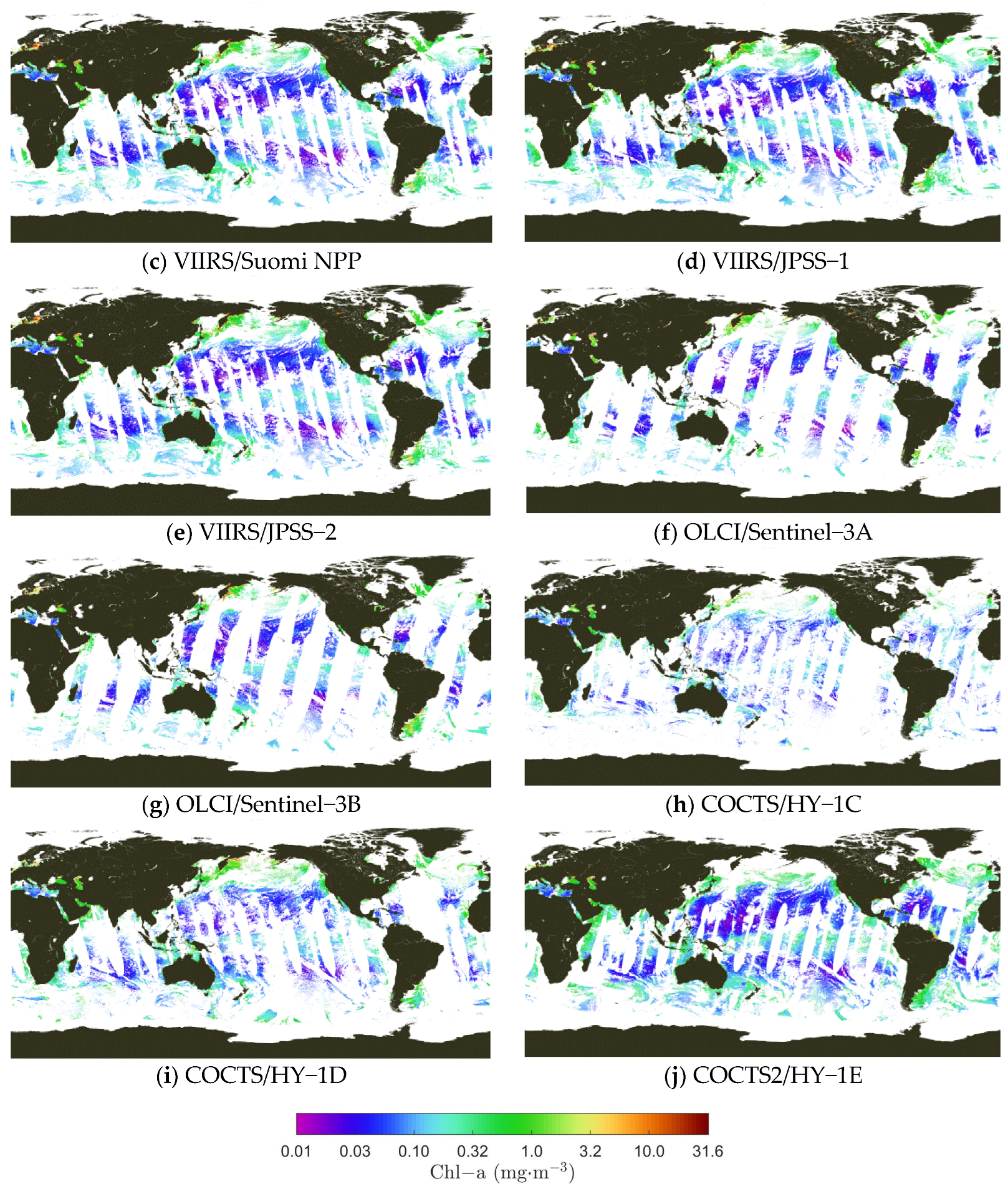


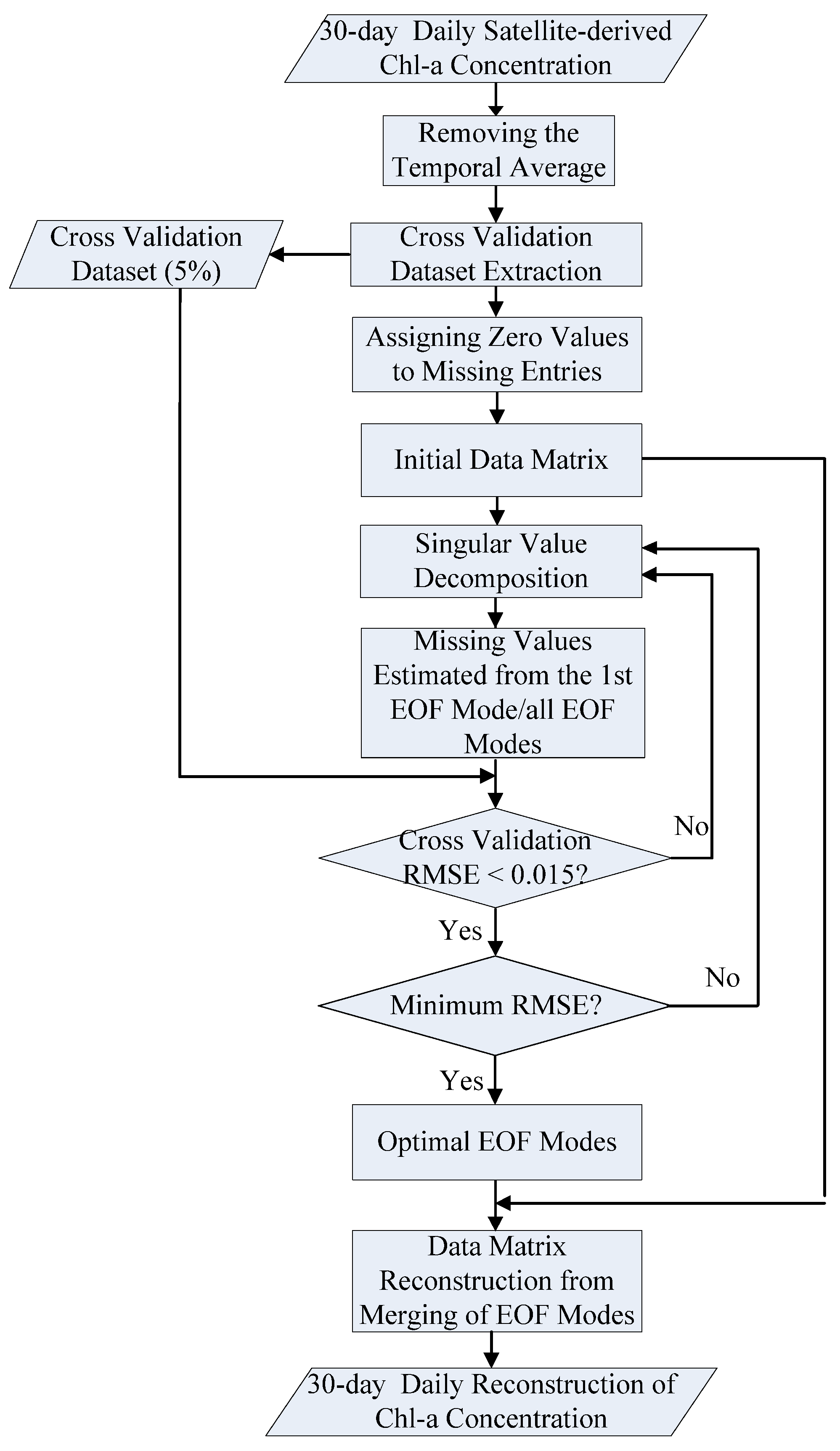
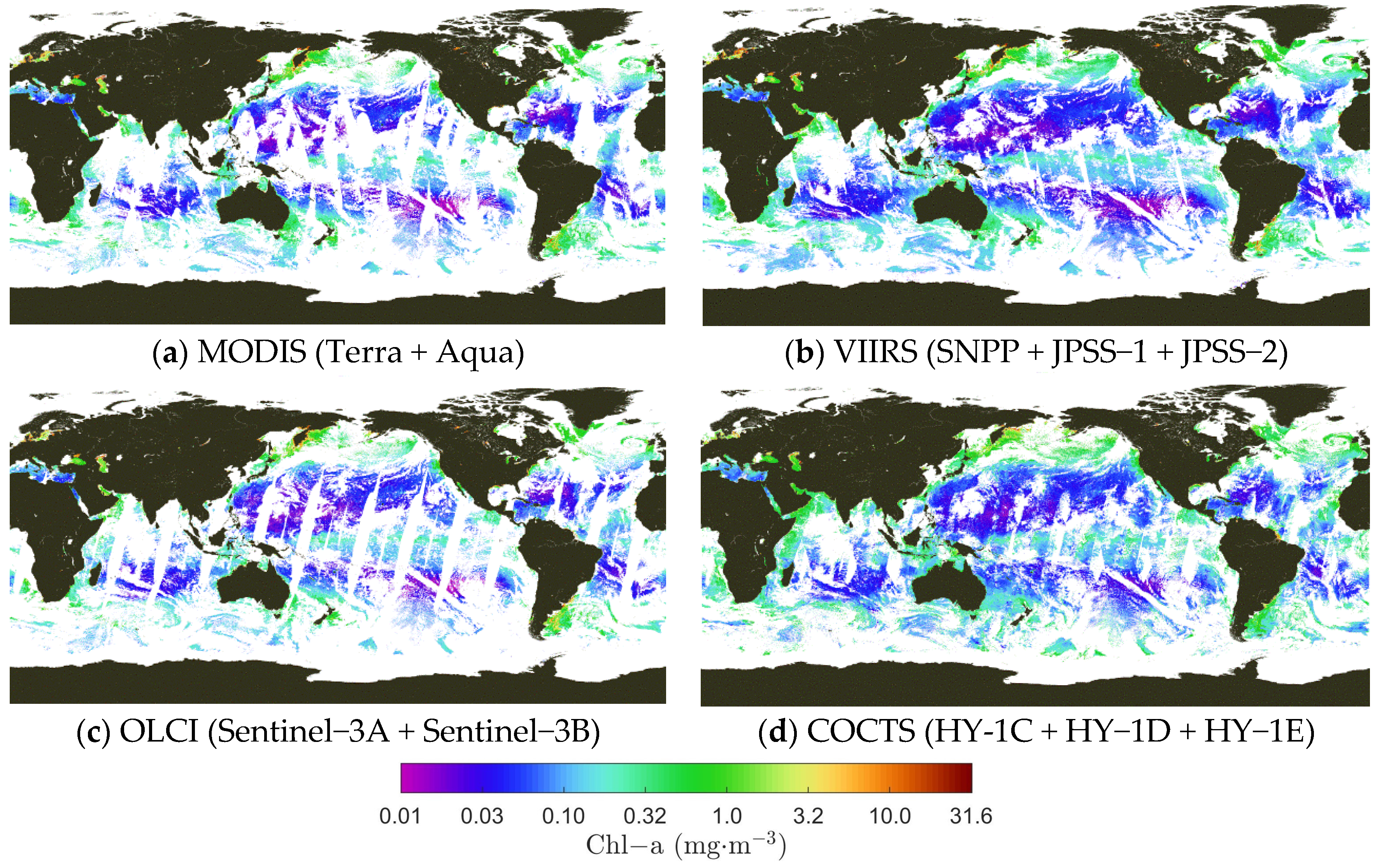
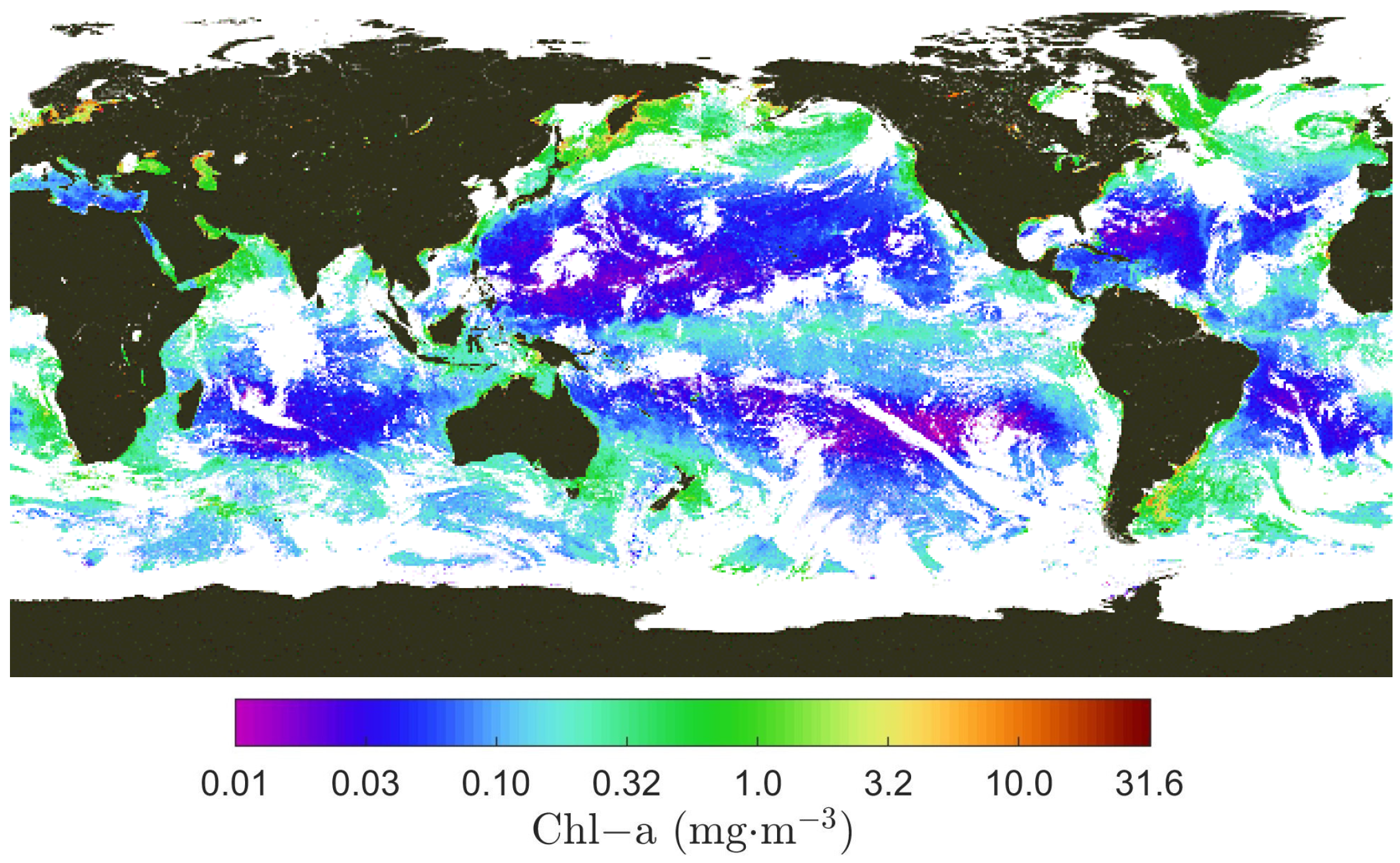
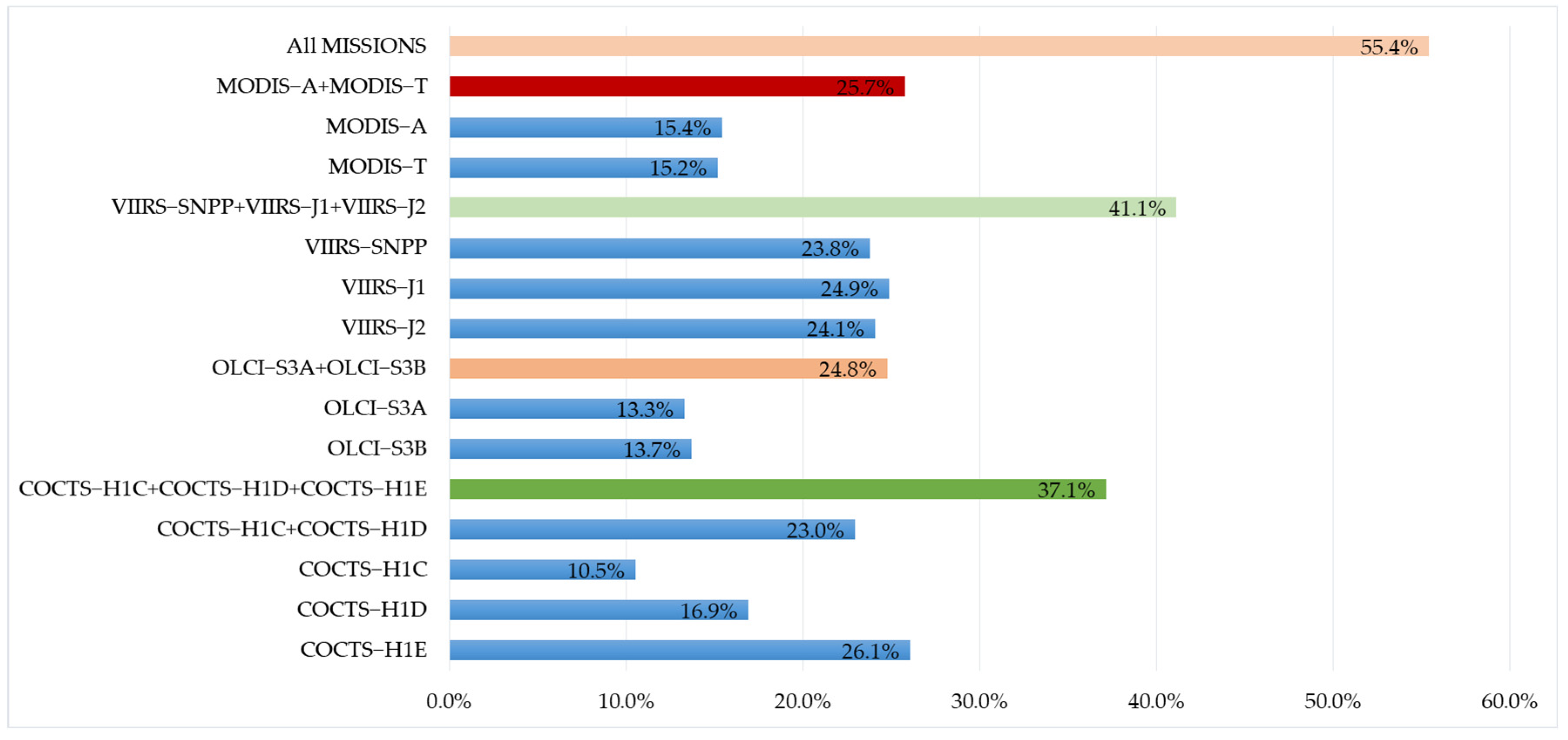
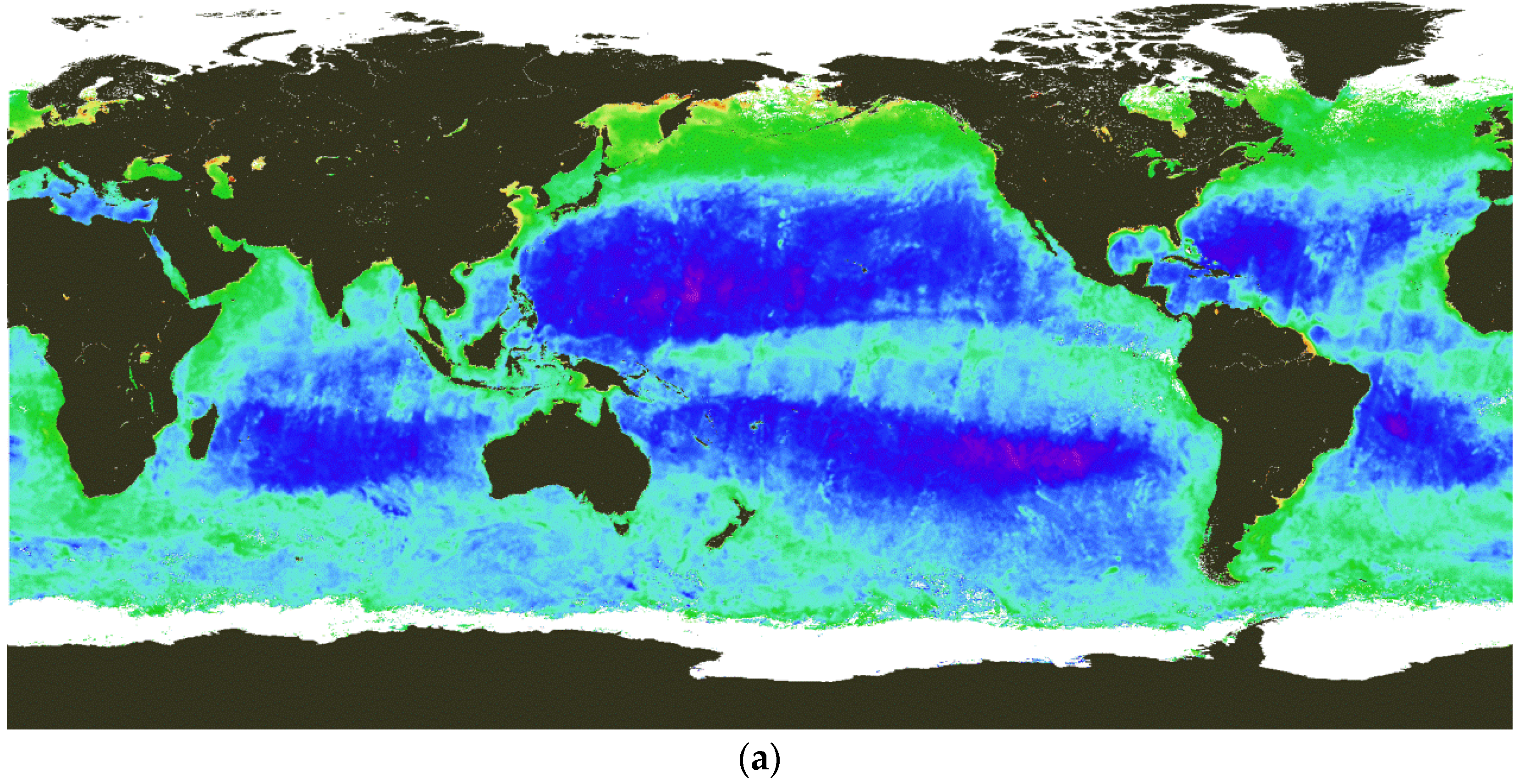

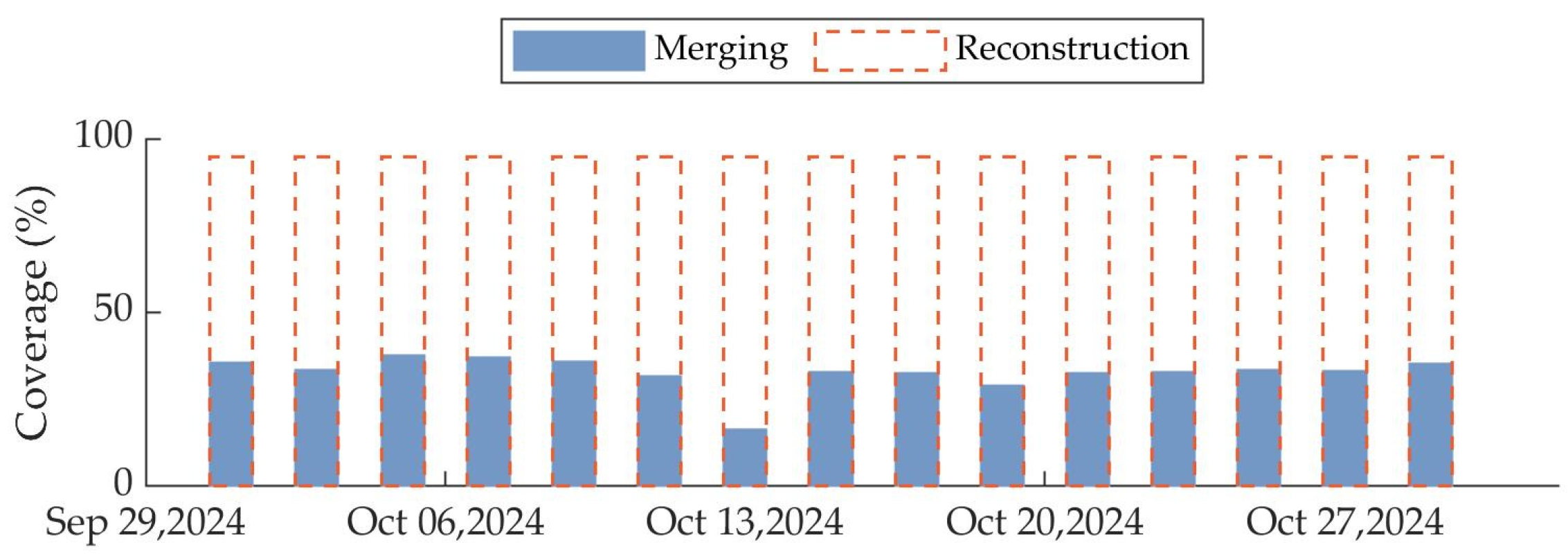
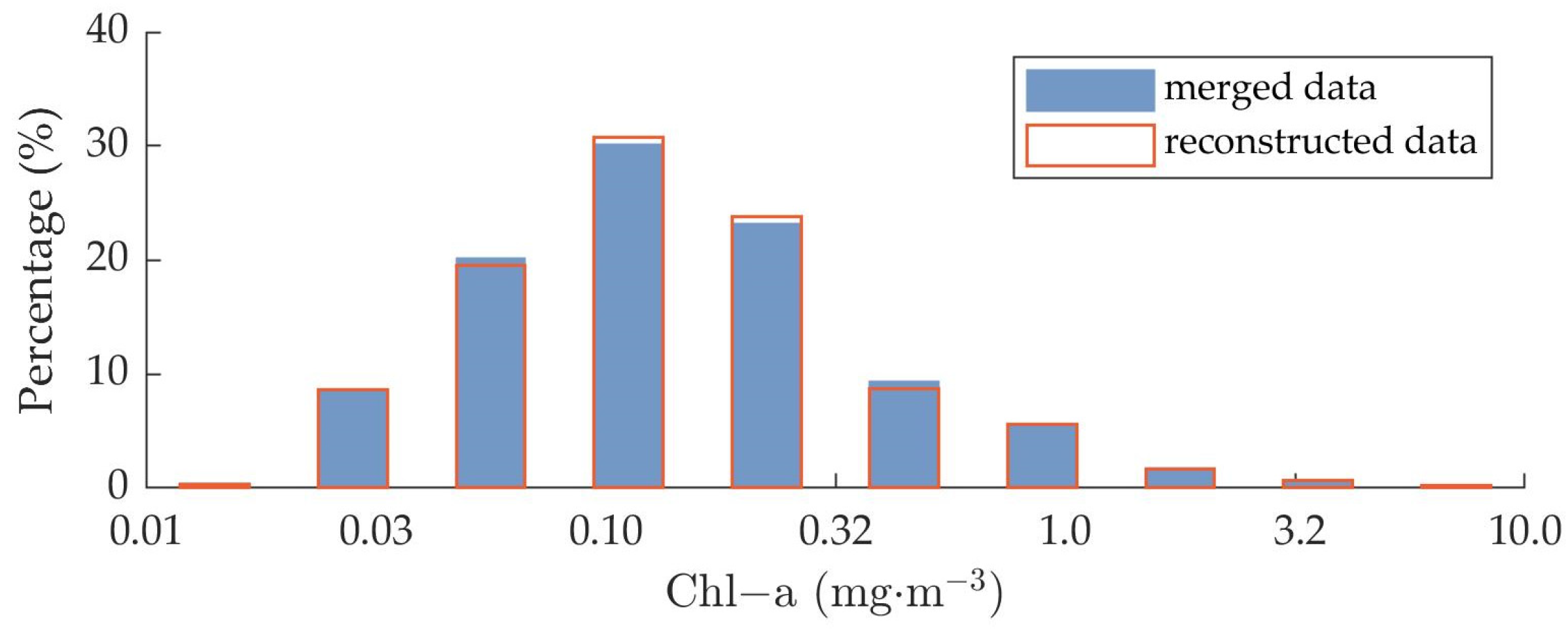

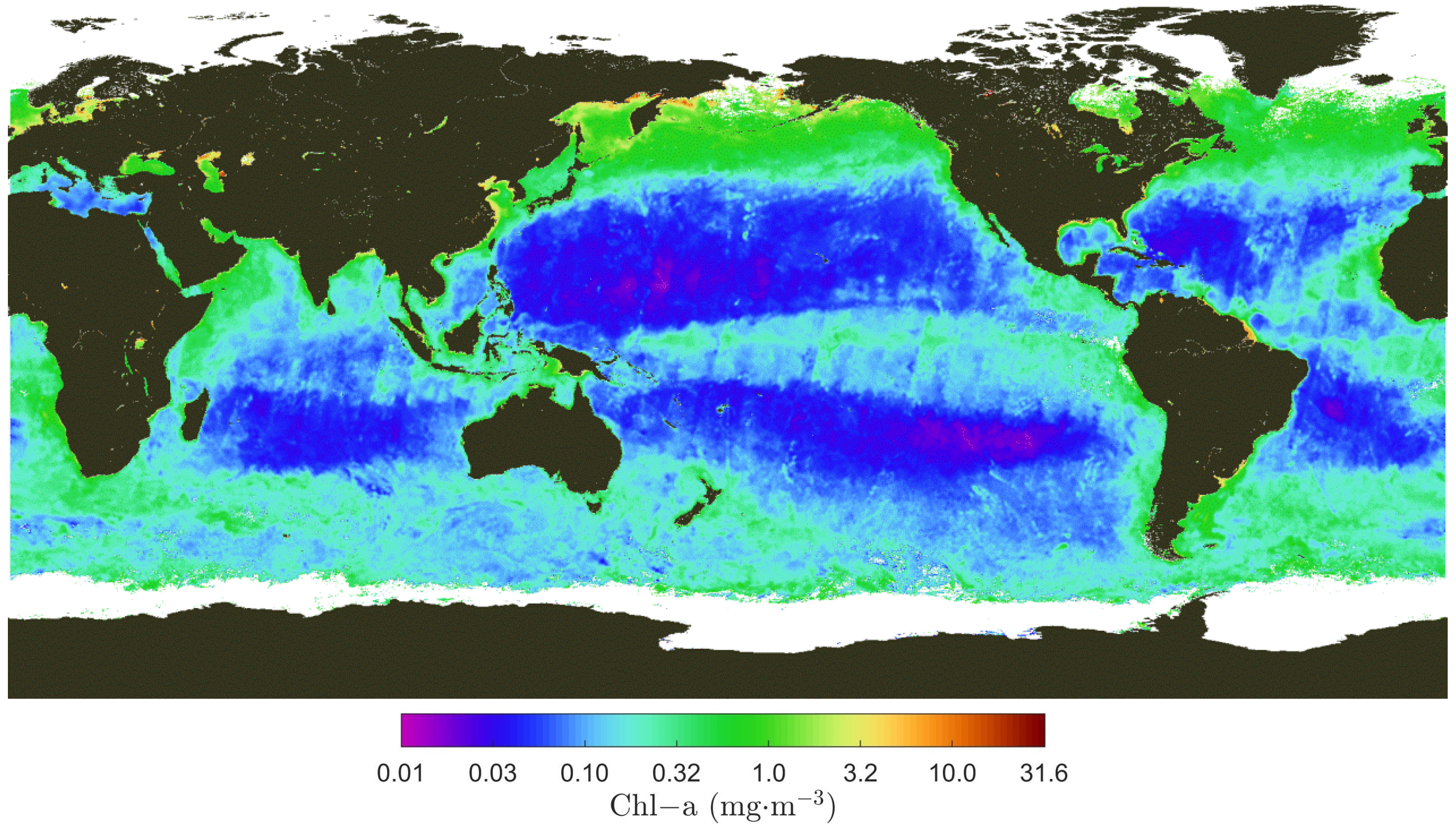
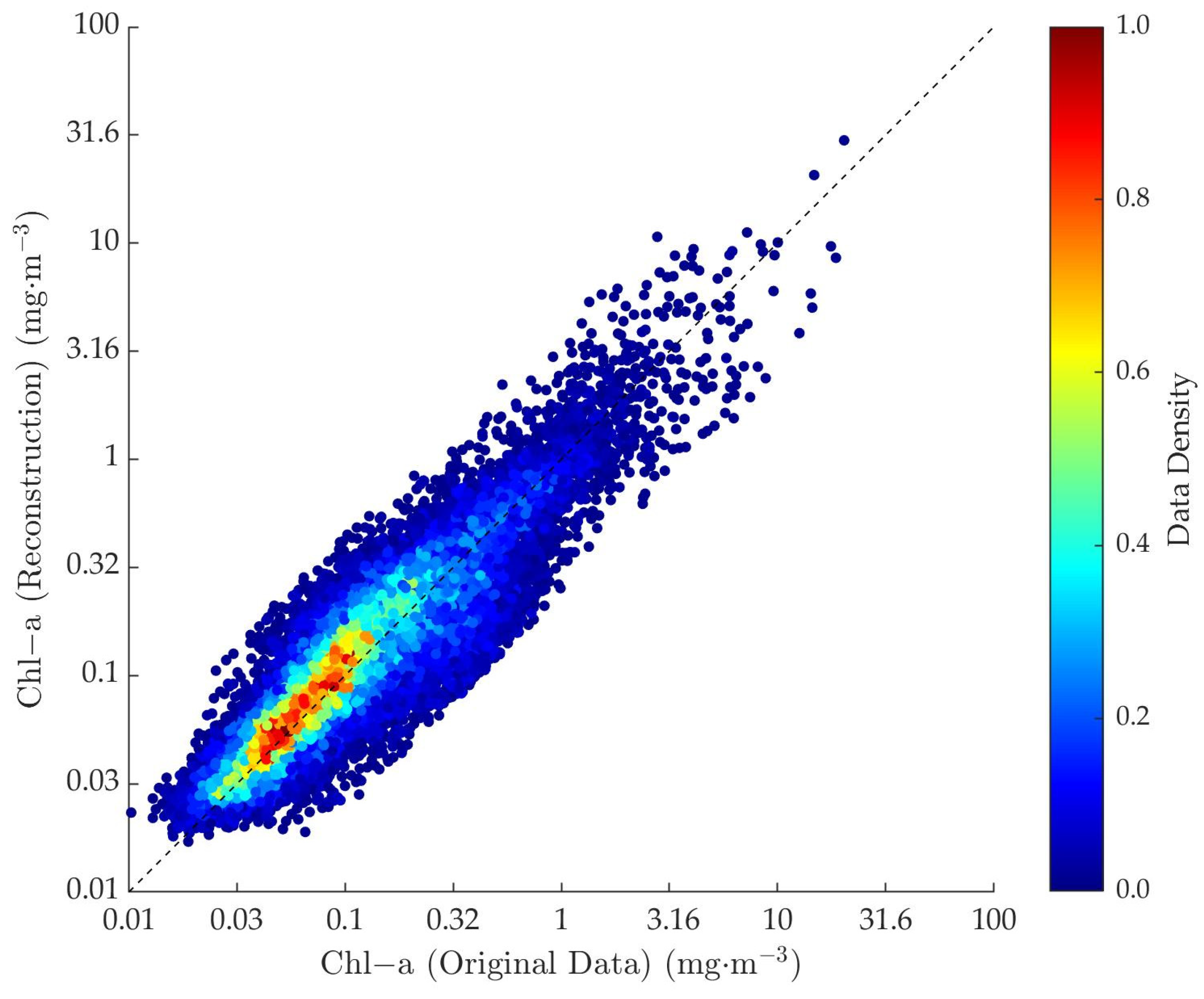

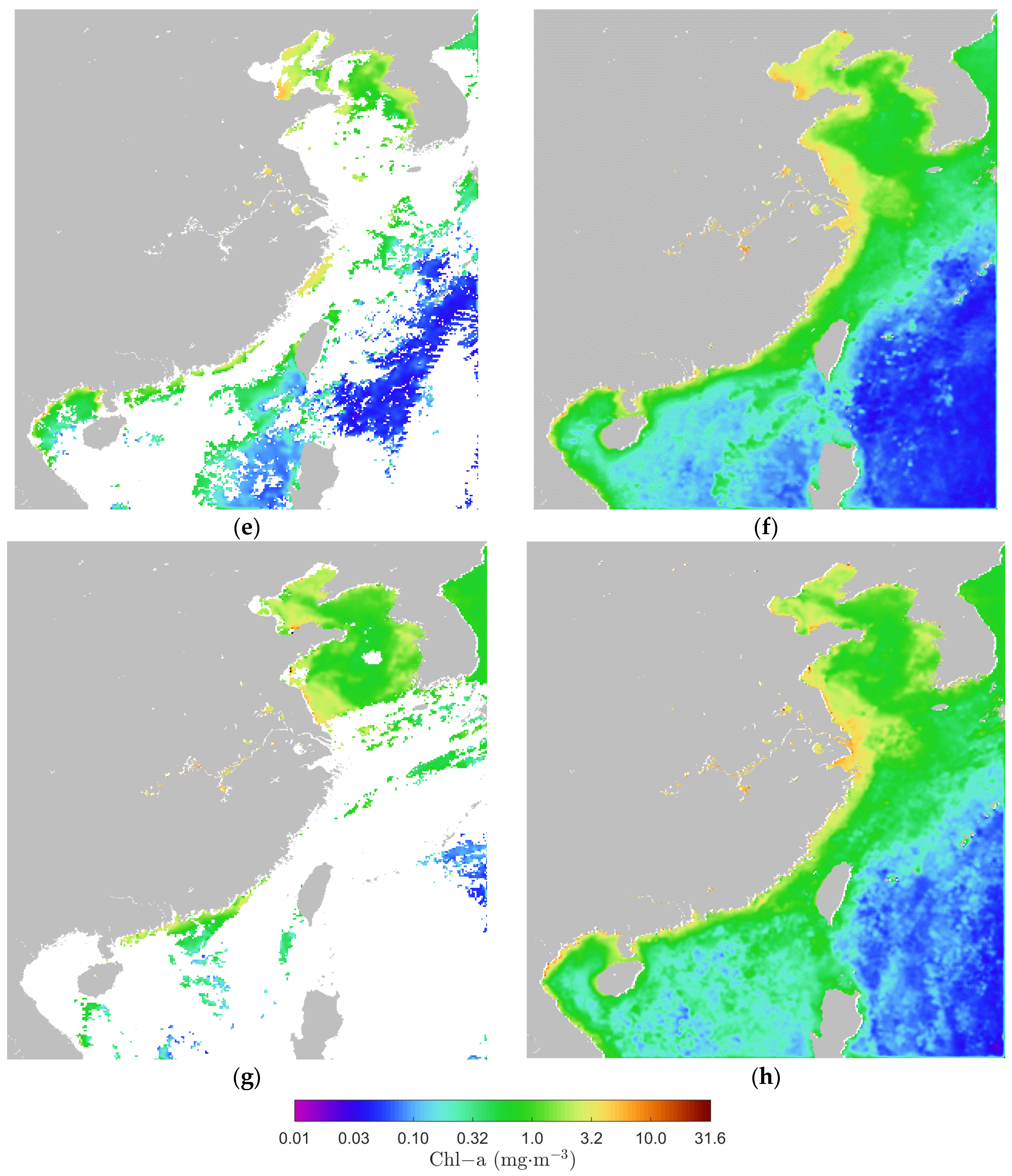
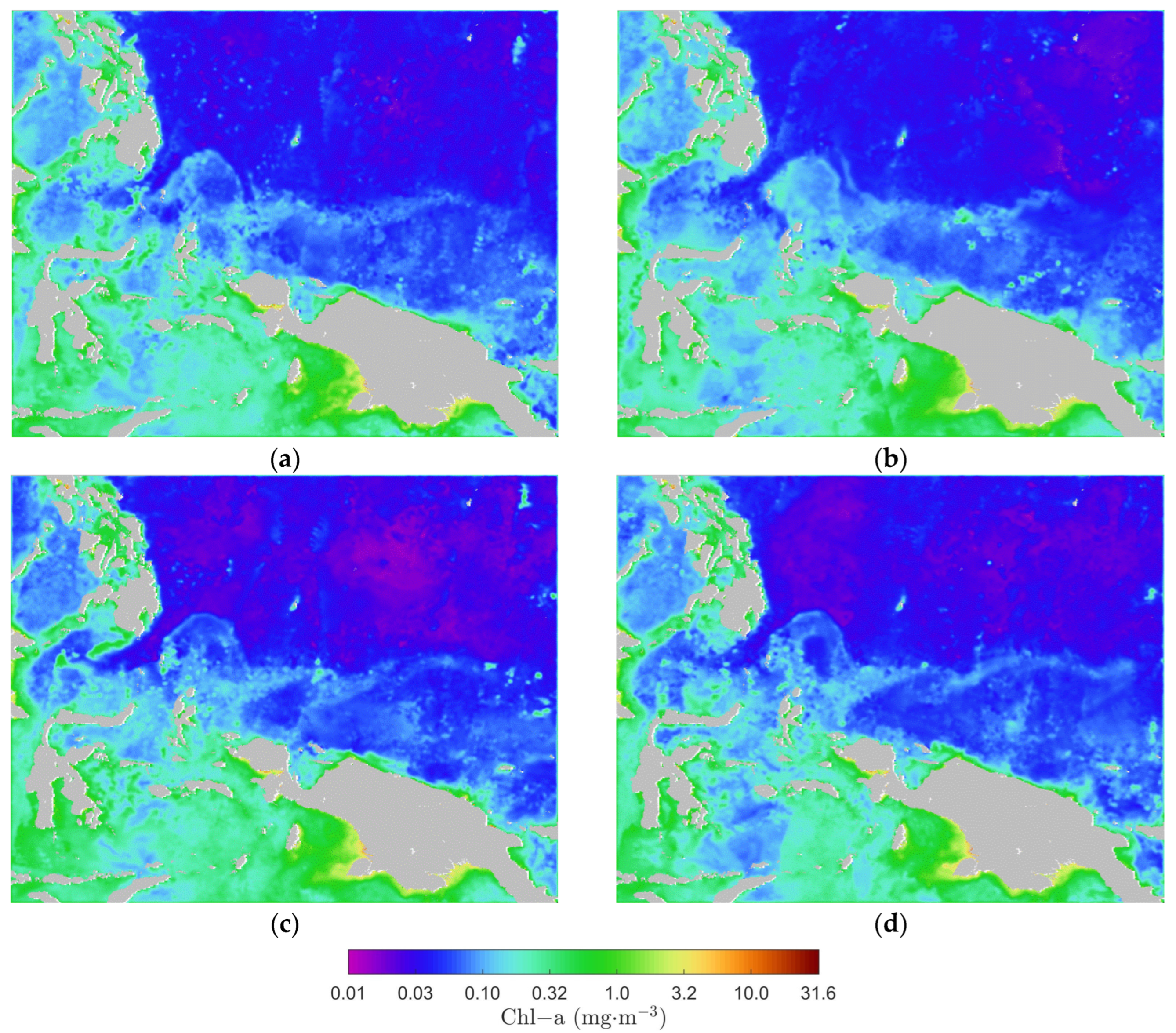
| No. | Sensor | Algorithm | OCx Rrs Used 1 |
|---|---|---|---|
| 1 | MODIS/Terra and Aqua | OC3M, CI | Rrs(443 > 488)/Rrs(547) |
| 2 | VIIRS/Suomi NPP | OC3_VIIRS_SNPP, CI | Rrs(443 > 486)/Rrs(551) |
| 3 | VIIRS/JPSS-1 | OC3_VIIRS_NOAA20, CI | Rrs(445 > 489)/Rrs(556) |
| 4 | VIIRS/JPSS-2 | OC3_VIIRS_NOAA21, CI | Rrs(445 > 488)/Rrs(555) |
| 5 | OLCI/Sentinel-3A and Sentinel-3B | OC4, CI | Rrs(443 > 490 > 510)/Rrs(560) |
| 6 | COCTS/HY-1C and HY-1D | OC4, CI | Rrs(443 > 490 > 520)/Rrs(565) [28] |
| 7 | COCTS2/HY-1E | OC4, CI | Rrs(443 > 490 > 520)/Rrs(565) [37] |
Disclaimer/Publisher’s Note: The statements, opinions and data contained in all publications are solely those of the individual author(s) and contributor(s) and not of MDPI and/or the editor(s). MDPI and/or the editor(s) disclaim responsibility for any injury to people or property resulting from any ideas, methods, instructions or products referred to in the content. |
© 2025 by the authors. Licensee MDPI, Basel, Switzerland. This article is an open access article distributed under the terms and conditions of the Creative Commons Attribution (CC BY) license (https://creativecommons.org/licenses/by/4.0/).
Share and Cite
Ye, X.; Lin, M.; Zou, B.; Wang, X.; Lin, Z. Reconstructing Global Chlorophyll-a Concentration for the COCTS Aboard Chinese Ocean Color Satellites via the DINEOF Method. Remote Sens. 2025, 17, 3433. https://doi.org/10.3390/rs17203433
Ye X, Lin M, Zou B, Wang X, Lin Z. Reconstructing Global Chlorophyll-a Concentration for the COCTS Aboard Chinese Ocean Color Satellites via the DINEOF Method. Remote Sensing. 2025; 17(20):3433. https://doi.org/10.3390/rs17203433
Chicago/Turabian StyleYe, Xiaomin, Mingsen Lin, Bin Zou, Xiaomei Wang, and Zhijia Lin. 2025. "Reconstructing Global Chlorophyll-a Concentration for the COCTS Aboard Chinese Ocean Color Satellites via the DINEOF Method" Remote Sensing 17, no. 20: 3433. https://doi.org/10.3390/rs17203433
APA StyleYe, X., Lin, M., Zou, B., Wang, X., & Lin, Z. (2025). Reconstructing Global Chlorophyll-a Concentration for the COCTS Aboard Chinese Ocean Color Satellites via the DINEOF Method. Remote Sensing, 17(20), 3433. https://doi.org/10.3390/rs17203433





